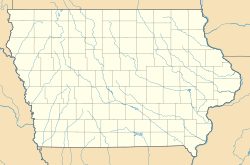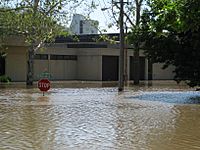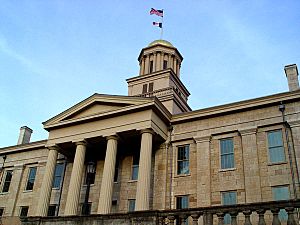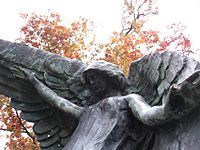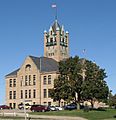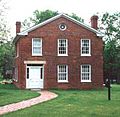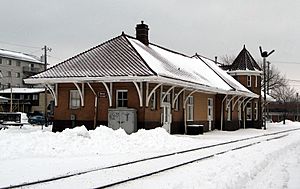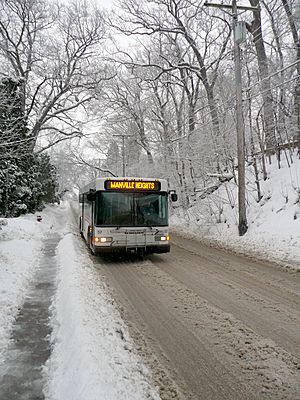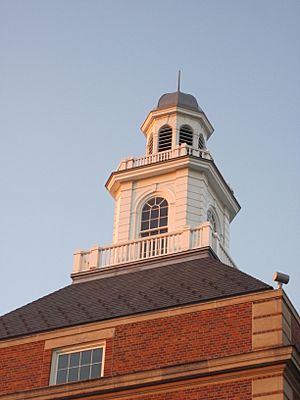Iowa City, Iowa facts for kids
Quick facts for kids
Iowa City, Iowa
|
||
|---|---|---|
|
City
|
||
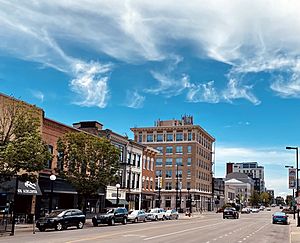
Downtown Iowa City, June 2021
|
||
|
||
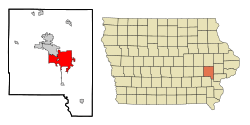
Location within Johnson County and Iowa
|
||
| Country | United States | |
| State | Iowa | |
| County | Johnson | |
| Government | ||
| • Type | Council-manager government | |
| Area | ||
| • City | 26.19 sq mi (67.82 km2) | |
| • Land | 25.65 sq mi (66.43 km2) | |
| • Water | 0.54 sq mi (1.40 km2) | |
| Elevation | 668 ft (203.6 m) | |
| Population
(2020)
|
||
| • City | 74,828 | |
| • Rank | 5th in Iowa | |
| • Density | 2,917.50/sq mi (1,126.47/km2) | |
| • Metro | 171,491 | |
| • Demonym | Iowa Citian | |
| Time zone | UTC−6 (CST) | |
| • Summer (DST) | UTC−5 (CDT) | |
| ZIP codes |
52240, 52242 – 52246
|
|
| Area code | 319 | |
| FIPS code | 19-38595 | |
| GNIS feature ID | 0457827 | |
| Interstate | ||
| Website | icgov.org | |
Iowa City is a city in Johnson County, Iowa, United States. It is the home of the University of Iowa and county seat of Johnson County, at the center of the Iowa City Metropolitan Statistical Area. At the time of the 2020 census the population was 74,828, making it the state's fifth-largest city. The metropolitan area, which encompasses Johnson and Washington counties, has a population of over 171,000. The Iowa City Metropolitan Statistical Area (MSA) is also a part of a Combined Statistical Area (CSA) with the Cedar Rapids MSA. This CSA plus two additional counties are known as the Iowa City-Cedar Rapids region which collectively has a population of nearly 500,000.
Iowa City was the second capital of the Iowa Territory and the first capital city of the State of Iowa. The Old Capitol building is a National Historic Landmark in the center of the University of Iowa campus. The University of Iowa Art Museum and Plum Grove, the home of the first Governor of Iowa, are also tourist attractions. In 2008, Forbes magazine named Iowa City the second-best small metropolitan area for doing business in the United States.
Contents
History
Iowa City was created by an act of Legislative Assembly of the Iowa Territory on January 21, 1839, fulfilling the desire of Governor Robert Lucas to move the capital out of Burlington and closer to the center of the territory. This act began:
"An Act to locate the Seat of Government of the Territory of Iowa...so soon as the place shall be selected, and the consent of the United States obtained, the commissioners shall proceed to lay out a town to be called "Iowa City".
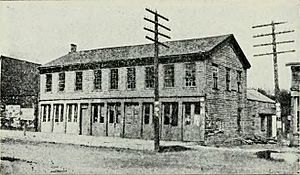
Commissioners Chauncey Swan and John Ronalds met on May 1 in the small settlement of Napoleon, south of present-day Iowa City, to select a site for the new capital city. The following day the commissioners selected a site on bluffs above the Iowa River north of Napoleon, placed a stake in the center of the proposed site and began planning the new capital city. Commissioner Swan, in a report to the legislature in Burlington, described the site:
"Iowa City is located on a section of land laying in the form of an amphitheater. There is an eminence on the west near the river, running parallel with it."
By June of that year, the town had been platted and surveyed from Brown St. in the north to Burlington St. in the south, and from the Iowa River eastward to Governor St.
While Iowa City was selected as the territorial capital in 1839, it did not officially become the capital city until 1841; after construction on the capitol building had begun. The capitol building was completed in 1842, and the last four territorial legislatures and the first six Iowa General Assemblies met there until 1857, when the state capital was moved to Des Moines.
Iowa Old Capitol Building
John F. Rague is credited with designing the Territorial Capitol Building. He had previously designed the 1837 capitol of Illinois and was supervising its construction when he got the commission to design the new Iowa capitol in 1839. He quit the Iowa project after five months, claiming his design was not followed, but the resemblance to the Illinois capitol suggests he strongly influenced the final Iowa design. One surviving 1839 sketch of the proposed capital shows a radically different layout, with two domes and a central tower. The cornerstone of the Old Capitol Building was laid in Iowa City on July 4, 1840. Iowa City served as the third and last territorial capital of Iowa, and the last four territorial legislatures met at the Old Capitol Building until December 28, 1846, when Iowa was admitted into the United States as the 29th state of the union. Iowa City was declared the state capital of Iowa, and the government convened in the Old Capitol Building.
1843 Cemetery
Oakland Cemetery was deeded to "the people of Iowa City" by the Iowa territorial legislature on February 13, 1843. The original plot was one block square, with the southwest corner at Governor and Church. Over the years the cemetery has been expanded and now encompasses 40 acres. Oakland Cemetery is a non-perpetual care city cemetery. This cemetery is supported by city taxes. The staff is strongly committed to the maintenance and preservation of privately owned lots and accessories. Since its establishment, the cemetery has become the final resting place of many men and women important in the history of Iowa, of Iowa City and the University of Iowa. These include Robert E. Lucas, first governor of the territory (1838–41); Samuel J. Kirkwood, governor during the Civil War (1860–64), again in 1876, a U.S. senator in 1877, and subsequently secretary of the interior and U.S. minister to Spain; well-known presidents of the university, Walter A. Jessup (1915–33) and Virgil M. Hancher (1940–64); Cordelia Swan, daughter of one of the three commissioners who selected the site for Iowa City and the new territorial capitol; and Irving B. Weber (1900-1997), noted Iowa City historian. It is also home to the legendary monument called the "Black Angel", which is an 8.5 foot tall monument for the Feldevert family erected in 1912. The facts behind the Black Angel long ago gave way to myths, superstitions and legend surrounding its mysterious change in color from a golden bronze cast to an eerie black.
1847 University Founding
Founded in 1847, today's University of Iowa is recognized as one of the nation's top public universities, offering more than 100 areas of study for its 31,112 students. The institution's Writers' Workshop is internationally acclaimed, having fostered the creative talents of Wallace Stegner, Raymond Carver, Flannery O'Connor, T.C. Boyle, Rita Dove, John Casey, John Irving, Gail Godwin and Jane Smiley, and having as permanent or visiting faculty many prominent writers including its early director Paul Engle, Philip Roth, John Cheever, Nelson Algren, Frank Conroy, Marilynne Robinson and Kurt Vonnegut. The University also includes one of the leading medical schools and one of the largest university-owned teaching hospitals in the nation. Providing patient care within 16 medical specialties, the University of Iowa Hospitals and Clinics have been named one of "America's Best Hospitals" by U.S. News & World Report magazine. Iowa City is also home to Mercy Hospital, a pre-eminent provider of healthcare to the region.
The university is also home to the University of Iowa College of Law. The College of Law has been consistently ranked among the nations top 25 law schools, boasting some of the best employment and bar passage rate in the country.
1970 Riots
The spring of 1970 was a tumultuous time on college campuses. On April 30, President Richard Nixon announced that U.S. forces would invade Cambodia because of the recent communist coup. Students around the country protested this escalation of the Vietnam War. On May 4, the National Guard fired on students at Kent State University, killing 4 and wounding 9 people, which ignited protests all over the country.
Anti-war protests were not new to Iowa City or to elsewhere in Iowa; protests had been occurring throughout the 1960s. Spring of 1970 was different.
After the Kent State shootings, students marched on the National Guard Armory, broke windows there and also in some downtown businesses. The City Council gave the mayor curfew powers. On May 6 there was a student boycott of classes. That night about 400 people had a “sleep-in” in front of the Old Capitol. That night about 50 people broke into the Old Capitol and set off a smoke bomb. The protesters left voluntarily when asked to do so. Around 2 AM Friday morning President Boyd requested arrest of the students on the Pentacrest by highway patrolmen, but the next day he regretted the mass arrests and said he had received faulty information. On May 8, President Boyd cancelled the 89th annual Governor’s day ROTC observance for the following day. On Friday and Saturday a National Guard helicopter circled the Pentacrest.
In the early morning hours of Saturday, May 9, the Old Armory Temporary (O.A.T.), also known as “Big Pink”, which housed the writing lab, was burned down. This building was located next to the Old Armory, where the Adler Journalism and Mass Communications building currently is located. O.A.T was said to be at the top of a list of buildings for burning, probably due to its poor condition and was considered a firetrap.
The Iowa Alumni Review includes an article about the fire in which the author states: “Only the ends stayed upright. … On the south, Lou Kelly’s Writing lab bearing the sign ‘another mother for peace,’ escaped.” There was a second, smaller fire on Saturday evening in a restroom in the East Hall Annex.
By Sunday morning, President Boyd gave students the option to leave. Classes were not cancelled but students could leave and take the grade they currently had. An account of the May 1970 protests can be read in the June–July issue of the Iowa Alumni Review.
In his autobiography, My Iowa Journey: The Life Story of the University of Iowa’s First African American Professor, Philip Hubbard (University Vice-Provost in 1970) gives an administrator’s perspective of all the protests of the 1960s. He supported the students' right to protest and in 1966 stated: “Students should not accept everything that is dished out to them. We don’t want to dictate what they should or should not do. However, student demonstrations should remain within the law and good taste without interfering with the university’s primary purpose of instructing students.”
During this time there was also a strong ROTC presence on campus. Their presence on campus and the academic credit they received for their service was called into question by both students and faculty in the spring of 1970, but Boyd said he could not abolish ROTC. The Alumni Review had an article called “ROTC: Alive and well at Iowa” in the December 1969 issue which helps provide a more complete picture of this period in history.
2006 Tornadoes
On the evening of April 13, 2006, a confirmed EF2 tornado struck Iowa City, causing severe property damage and displacing many from their homes, including many University of Iowa students. It was the first tornado ever recorded to hit the city directly. No serious injuries were reported in the Iowa City area.
A popular Dairy Queen, which had been in business for 54 years, was a victim of the storm (but it reopened in late September), along with two large car dealerships, and several other businesses along Riverside Drive and Iowa Highway 1. The 134-year-old Saint Patrick's Catholic Church was heavily damaged only minutes after Holy Thursday Mass, with most of its roof destroyed. The building was ruled a total loss and has since been demolished. The downtown business district as well as the eastern residential area and several parks suffered scattered damage of varying degrees.
Additionally, several houses in the sorority row area were destroyed. The Alpha Chi Omega house was nearly destroyed, though no one was injured and the building was later razed. Cleanup efforts were under way almost immediately as local law enforcement, volunteer workers from all over the state, and Iowa City residents and college students worked together to restore the city. The total cost of damage was estimated at around $12 million--$4 million of which was attributed to Iowa City and Johnson County Property.
2008 Flood
A local newspaper reported on June 11, 2008, that water exceeded the emergency spillway at the Coralville Reservoir outside of Iowa City. As a result, the City of Iowa City and the University of Iowa were seriously affected by unprecedented flooding of the Iowa River, which caused widespread property damage and forced evacuations in large sections of the city. By Friday June 13, 2008, the Iowa River had risen to a record level of 30.46 feet (9.28 m) (5:00 PM CST) with a crest of approximately 33 feet (10 m) predicted for Wednesday June 18, 2008. Much of the city’s 500-year floodplain saw mild to catastrophic effects of the rapidly flowing, polluted water. Officials at the University of Iowa reported that up to 19 buildings were affected by rising waters. Extensive efforts to move materials from the University’s main library were undertaken as large groups of sandbagging volunteers began to construct a massive levee near the building. Approximately $300 million worth of art, including work by Picasso, owned by the University was secretly moved to a holding place in the Chicago area before the fine arts area was heavily hit with flood water.
On Friday, June 13, university employees were encouraged to stay home, and travel was strongly discouraged in Iowa City; one city statement advised, "If you live in east Iowa City, stay in east Iowa City; if you live in west Iowa City, stay in west Iowa City." The Burlington St. bridge was the only bridge that remained open, other than the I-80 bridge on the edge of town, to connect the east and west sides of the Iowa River. On Saturday, June 14, officials at the University of Iowa began to power down the University's primary power generating plant along the Iowa River to prevent structural damage. Backup units continued to provide necessary power and steam services for essential University services, including the University of Iowa Hospitals and Clinics. Water began touching the bottom of the Park St. bridge forcing the Army Corp. of Engineers to drill several holes in the bridge to allow air trapped underneath to escape. Also on Saturday, Mayor Regenia Bailey issued a curfew restricting anyone except those authorized by law enforcement from being within 100 yards (91 m) of any area affected by the flood between 8:30PM and 6:00 AM.
Prior to the flood, a University of Iowa construction site was effectively damming the river just north of the bridge at Iowa Avenue and south of the train bridge crossing the river adjacent to the Iowa Memorial Union. The site had been erected ten months prior, presumably in order to work on the University of Iowa steam power and thermal control system. It is unknown whether the Army Corps of Engineers were persuaded by University officials to maintain water levels below 26 feet (7.9 m) in order to maintain the work site in the three weeks preceding the major flood event, or if Army Corps of Engineers made the decision to preserve the site on their own. This is a fact that many of Iowa City's riverside residents are aware of, particularly those living along Normandy Drive adjacent to City Park. This dam structure has been referred to as the "copper dam" because of its rusty orange color. The structure almost certainly impeded flow of the river, and the Army Corps of Engineers' decision to forgo the discharge of additional multi-thousands of cubic feet of water in weeks prior has been criticized by many, and displaced residents even attempted to bring a class action lawsuit against the Army Corps of Engineers and the University of Iowa.
Geography and climate
Iowa City is located along the Iowa River.
According to the United States Census Bureau, the city has a total area of 25.28 square miles (65.47 km2), of which, 25.01 square miles (64.78 km2) is land and 0.27 square miles (0.70 km2) is water.
The elevation at the Iowa City Municipal Airport is 668 ft (203.6 m) above sea level.
| Climate data for Iowa City, Iowa | |||||||||||||
|---|---|---|---|---|---|---|---|---|---|---|---|---|---|
| Month | Jan | Feb | Mar | Apr | May | Jun | Jul | Aug | Sep | Oct | Nov | Dec | Year |
| Average high °F (°C) | 32 (0) |
35 (2) |
46 (8) |
61 (16) |
73 (23) |
82 (28) |
87 (31) |
85 (29) |
78 (26) |
67 (19) |
49 (9) |
36 (2) |
61 (16) |
| Average low °F (°C) | 15 (−9) |
18 (−8) |
27 (−3) |
39 (4) |
50 (10) |
60 (16) |
64 (18) |
62 (17) |
53 (12) |
42 (6) |
29 (−2) |
19 (−7) |
40 (5) |
| Average precipitation inches (mm) | 1.5 (38) |
1.4 (36) |
2.3 (58) |
3.0 (76) |
4.2 (110) |
4.7 (120) |
4.1 (100) |
3.9 (99) |
3.8 (97) |
2.7 (69) |
2.1 (53) |
1.6 (41) |
35.2 (890) |
| Source: Weatherbase | |||||||||||||
Demographics
| Historical populations | ||
|---|---|---|
| Year | Pop. | ±% |
| 1850 | 1,250 | — |
| 1860 | 5,214 | +317.1% |
| 1870 | 5,914 | +13.4% |
| 1880 | 7,123 | +20.4% |
| 1890 | 7,016 | −1.5% |
| 1900 | 7,987 | +13.8% |
| 1910 | 10,091 | +26.3% |
| 1920 | 11,267 | +11.7% |
| 1930 | 15,340 | +36.1% |
| 1940 | 17,182 | +12.0% |
| 1950 | 27,212 | +58.4% |
| 1960 | 33,443 | +22.9% |
| 1970 | 46,850 | +40.1% |
| 1980 | 50,508 | +7.8% |
| 1990 | 59,735 | +18.3% |
| 2000 | 62,220 | +4.2% |
| 2010 | 67,862 | +9.1% |
| 2020 | 74,828 | +10.3% |
| Source: and Iowa Data Center (PDF) Source: |
||
Iowa City is commonly known as a college town. It is home to the University of Iowa and a small campus of Kirkwood Community College. The population increases during the months when the two schools are in session.
As of the 2010 census, about 58.0% of adults held a bachelor's degree or higher and 79.7% were white alone, not Hispanic or Latino, 6.2% were Asian alone, and 5.8% were black alone, while the median household income was $41,410, about $10,000 less than the state median.
2010 census
As of the census of 2010, there were 67,862 people, 27,657 households, and 11,743 families residing in the city. The population density was 2,713.4 inhabitants per square mile (1,047.6/km2). There were 29,270 housing units at an average density of 1,170.3 per square mile (451.9/km2). The racial makeup of the city was 82.5% White, 5.8% African American, 0.2% Native American, 6.9% Asian, 2.1% from other races, and 2.5% from two or more races. Hispanic or Latino of any race were 5.3% of the population.
There were 27,657 households, of which 19.8% had children under the age of 18 living with them, 32.5% were married couples living together, 7.2% had a female householder with no husband present, 2.8% had a male householder with no wife present, and 57.5% were non-families. 34.3% of all households were made up of individuals, and 7% had someone living alone who was 65 years of age or older. The average household size was 2.22 and the average family size was 2.88.
The median age in the city was 25.6 years. 14.9% of residents were under the age of 18; 33.4% were between the ages of 18 and 24; 25.7% were from 25 to 44; 17.8% were from 45 to 64; and 8.2% were 65 years of age or older. The gender makeup of the city was 49.7% male and 50.3% female.
Metropolitan area
The Iowa City Metropolitan Statistical Area consists of Johnson and Washington counties in Iowa; Washington County was added to the MSA after the 2000 census. It had a 2000 census population of 131,676, and a 2010 population of 152,586.
Iowa City is contiguous with Coralville to the northwest. University Heights is completely contained within the boundaries of Iowa City, near Kinnick Stadium. Tiffin, North Liberty, Solon, and Hills are other towns within a few miles.
The Iowa City MSA and the nearby Cedar Rapids MSA are collectively a Combined Statistical Area (CSA). This CSA along with two additional counties are known as the Iowa City-Cedar Rapids (ICR) Corridor and collectively have a population of over 450,000.
Arts and culture
In the early 1970s, the Old Capitol was renovated and University administrative offices were relocated to Jessup Hall. All but one of the major rooms were restored to their appearance when Iowa City was the state capital. In November 2001 the cupola caught fire during the renovation of its gold leaf dome. The cupola was destroyed and the building was heavily damaged. In 2006, after an extensive restoration, the building re-opened to the public. The building now serves as the Old Capitol Museum, as well as a venue for speeches, lectures, press conferences and performances in the original state senate chamber.
The Iowa Avenue Literary Walk, a series of bronze relief panels that feature authors' words as well as attribution, is a tribute to the city's rich literary history. The panels are visually connected by a series of general quotations about books and writing stamped into the concrete sidewalk. All 49 authors and playwrights featured in the Literary Walk have ties to Iowa.
In November 2008, UNESCO designated Iowa City as the world's third City of Literature, making it a part of the UNESCO Creative Cities Network.
In 2004, the Old Capitol Cultural District was one of the first Cultural Districts certified by the State of Iowa. The district extends from the University of Iowa Pentacrest, south to the Johnson County Courthouse, east to College Green Park, and north into the historic Northside Neighborhood.
Utne Reader ranked Iowa City eighth in its 1997 survey of "America's 10 Most Enlightened Towns".
The February 2010 issue of The Advocate magazine had an article titled "Gayest Cities in America" which ranked Iowa City third in a list of 15 cities with an abundance of gay-friendly (male) resources, behind Atlanta, Georgia, and Burlington, Vermont. The article was reported and discussed in The Daily Iowan.
Cultural events
Iowa City has a variety of cultural events. It has a strong literary history and is the home of the Iowa Writers' Workshop, whose graduates include John Irving, Flannery O'Connor, T.C. Boyle, and many other prominent U.S. authors; the nation's leading Non-Fiction Writing Program; the Iowa Playwrights' Workshop; the Iowa Summer Writing Festival; and the International Writing Program, a unique residency program that has hosted writers from more than 120 countries.
Iowa City also sponsors a variety of events in the Summer of the Arts program. These include a nationally renowned jazz festival, a festival of the arts, open-air summer movies and free concerts every Friday night in the pedestrian mall (Ped Mall).
The Iowa City Book Festival began as an annual summer event in 2009 sponsored by the University of Iowa Libraries and in 2013 it was moved to October when management was handed off to the Iowa City UNESCO City of Literature. It features readings from prominent authors and literature themed events.
The Iowa Biennial Exhibition [TIBE] began in 2004 as an international survey of contemporary miniature printmaking held its initial exhibition at the University of Iowa. The 2006 exhibition, received a 2007 "ICKY" award nomination in Visual Arts Programming from the Iowa Cultural Corridor Alliance for its exhibition at the University of Iowa’s Project Art Gallery.
In 2007 Landlocked Film Festival was founded as an independent organization. Summer of the Arts was one of several sponsors. Many Landlocked Film Festival events are held at the historic Iowa City Englert Theatre.
Local landmarks
- Hancher Auditorium often hosts nationally touring theater, dance and musical shows, and has commissioned more than 100 works of music, theater and dance during the last 20 years. This facility was badly damaged during the Iowa flood of 2008 and the facility has been rebuilt farther uphill, away from the Iowa River and reopened in Fall of 2016.
- Hamburg Inn No. 2 is a favorite campaign stop for political candidates. It was featured in a 2005 episode of the political drama The West Wing. It has also been a favored campaign stop for many U.S. Presidents, including Bill Clinton and Ronald Reagan. It was featured in The New York Times for its widely renowned "pie shakes."
- Oakland Cemetery contains graves of notable locals as well as the "Black Angel" statue.
- Plum Grove Historic House was the residence of Robert Lucas, the first territorial governor of Iowa, and the novelist Eleanor Hoyt Brainerd.
- Moffitt cottages, built in a unique vernacular architectural style, are scattered around eastern Iowa City. "These mystical dwellings look as if Germanic elves constructed houses for Irish pixies," is how one writer described them.
- Prospect Hill
Historic places on the National Register
Pedestrian Mall
City Plaza (commonly called the Pedestrian Mall or simply Ped Mall) serves as a gathering place for students, locals, and the homeless, and draws large crowds for its summertime events such as the Friday Night Concert Series and the annual Iowa City Jazz Festival and Iowa City Arts Festival. The Ped Mall area contains restaurants, bars, retail, hotels, and the Iowa City Public Library. It is known for its appeal to various local artists and musicians, and its wild bar scene. The Coldren Opera House was located on the street which has now become the mall.
Parks and recreation
Hickory Hill Park is a large wooded park on the north side of town.
City Park is located across the river from north Dubuque Street, and contains walking paths, baseball diamonds, tennis courts and an outdoor pool complex.
Hubbard Park is directly adjacent to the south side of the Iowa Memorial Union building and is a large green space utilized by many students for team activities and events.
Thornberry Dog Park is on the east side of the river in-between two bends in the river referred to by developers as "the peninsula" upstream of City Park. This area is also home to a small Frisbee golf park which is often flooded.
College Green Park is located two blocks directly north of Burlington Street and two blocks east of Gilbert Street and is host to an annual gay pride parade during the spring or summer season.
Mercer Park is on the south east side of town directly adjacent to South East Junior High off of 1st Avenue. It contains play equipment, baseball diamonds and an indoor pool and recreation complex.
Scott Park is on the far east central side of town along Scott Boulevard to the east. It's a large park area with soccer fields, baseball diamonds, and lots of green space where many people walk their dogs.
Napoleon Park is on the very south side of Iowa City along Gilbert Street and hosts many baseball diamonds.
Whispering Prairie Wetlands Park is a nice pond and marsh area on the southeast side of town. It hosts many species of resident and migrating birds, including water fowl.
Court Hill Park is located south of Court Street and extends all the way to Ralston Creek on the south side of Friendship Street. It contains three pavilions, football field with uprights, an incomplete baseball diamond, and play equipment. Newly developed walking trail traverses this park.
Happy Hollow Park, created in 1945, is in Iowa City's historic North Side district at the corner of Brown Street and Governor Street. The facilities include a shelter with restrooms, a pavilion and seating for barbecues and other events, a softball diamond, and playground equipment.
Highland Park is a "pocket park", on the northwest corner of Keokuk Street and Highland Avenue. It features a small shelter (installed 2015), and play equipment installed in 2016, thanks to work by the Lucas Farms Neighborhood Association.
Transportation
Iowa City has a general aviation airport, the Iowa City Municipal Airport, on the south side of the city. The Eastern Iowa Airport, 20 miles (32 km) to the northwest, serves Iowa City and Cedar Rapids with scheduled passenger flights.
Interstate 80 runs east–west along the north edge of Iowa City. U.S. Highway 218 and Iowa Highway 27 (the Avenue of the Saints) are co-signed along a freeway bypassing Iowa City to the west. U.S. Highway 6 and Iowa Highway 1 also run through Iowa City.
Iowa City is served by the freight-only Iowa Interstate Railroad and the Cedar Rapids and Iowa City Railway (CRANDIC). The historic Iowa City Depot, shown in the picture at left, is no longer in use for railway services; it has been modified into a commercial office building.
In 2009, the Iowa City metropolitan statistical area (MSA) ranked as the seventh highest (tied with Hinesville-Fort Stewart, Georgia MSA) in the United States for percentage of commuters who walked to work (8.2 percent). In 2013, the Iowa City MSA ranked as the sixth lowest in the United States for percentage of workers who commuted by private automobile (73.4 percent). During the same year, 11.1 percent of Iowa City area commuters walked to work.
Buses
Iowa City Transit, Coralville Transit, and the University of Iowa's Cambus system provide public transportation.
Intercity bus transit is served at either the Court Street Transportation Center in Iowa City or the Coralville Transit Intermodal Facility in Coralville.
Cycling
There is a system of paved bicycle paths, especially along the Iowa River.
Some of the main roads also have designated bike lanes or sharrows, such as Jefferson street, Market street, and College street. As of 2017, both Iowa City and the University of Iowa have been awarded 'silver' status as a bicycle friendly community and university, respectively, by the League of American Bicyclists.
Economy
Iowa City is home to the University of Iowa Hospitals and Clinics (UIHC), the state's only comprehensive tertiary care medical center. The Holden Comprehensive Cancer Center in Iowa City is an NCI-designated Cancer Center, one of fewer than 60 in the country.
ACT college testing services is headquartered in Iowa City.
In 2004, Forbes magazine named Iowa City the third Best Small Metropolitan Area in the United States.
In June 2006, Kiplinger's Personal Finance rated Iowa City No. 10 on its list of the Top 50 Smart Places to Live.
Top employers
According to Iowa City's 2018 Comprehensive Annual Financial Report, the top employers in the city are:
| # | Employer | # of Employees |
|---|---|---|
| 1 | University of Iowa and University of Iowa Hospitals and Clinics | 29,705 |
| 2 | Iowa City VA Medical Center | 2,150 |
| 3 | Iowa City Community School District | 1,575 |
| 4 | Mercy Hospital | 1,325 |
| 5 | ACT Inc. | 1,187 |
| 6 | Procter & Gamble | 1,084 |
| 7 | Hy-Vee | 1,012 |
| 8 | City of Iowa City | 931 |
| 9 | Pearson | 775 |
| 10 | Johnson County | 609 |
Sports
Iowa City is home of the University of Iowa's athletic teams, known as the Iowa Hawkeyes. A member of the Big Ten Conference, the football team plays at Kinnick Stadium, while men's and women's basketball, volleyball, and the wrestling and gymnastics teams compete at Carver-Hawkeye Arena. The Hawkeyes football team regularly sends players to the NFL, including Super Bowl Champion all-pro Baltimore Ravens guard Marshall Yanda, 2004 2nd overall draft pick Robert Gallery, and San Francisco 49ers tight end George Kittle, among many others. Kirk Ferentz is the longest tenured head coach in NCAA FBS dating back to the 1999–2000 season.
Iowa City's three public high schools, City, West, and Liberty, are members of the Mississippi Valley Conference. Regina competes in the River Valley Conference.
The Iowa City Gold Sox were a semi-professional baseball team that called Iowa City home from 1912 through 1913.
Education
The Iowa City Community School District operates public schools in Iowa City. Iowa City High School, Iowa City West High School, Liberty High School are the three public high schools. Iowa City is also home to the private PK-12 school district, Regina Catholic Education Center. Iowa City is home to The University of Iowa and a branch of Kirkwood Community College.
The Iowa City Japanese School (アイオワシティ補習授業校 Aiowa Shiti Hoshū Jugyō Kō), a weekend educational program for Japanese nationals, provides Japanese language instruction, holding its classes at Zion Lutheran Church.
Notable people
- Nancy C. Andreasen, distinguished psychiatrist and professor at University of Iowa
- George Washington Ball (1847–1915), Iowa State Senator, Representative, and Iowa City mayor (1905–1909)
- Janusz Bardach, gulag survivor, author, and noted plastic surgeon.
- Bob Barr, former Georgia congressman and 2008 presidential candidate
- Brian Bell, guitarist of the alternative rock band Weezer
- Moses Bloom, former mayor of Iowa City and the first Jewish mayor of any major American city
- Eleanor Hoyt Brainerd, popular novelist
- Greg Brown, folk musician
- Ethan Canin, writer
- Thomas R. Cech, 1989 Nobel Prize winner in chemistry; graduate from Iowa City High School
- Harry Chase, 19th-century American marine painter. Received first comprehensive art instruction in Iowa City as a boy.
- Eli P. Clark, railroad man
- James Claussen, lithographer, abstract painter
- Iris DeMent, musician, lives in Iowa City
- Peter A. Dey, Mayor of Iowa City, civil engineer and banker
- Edward M. Doe, Arizona Territorial jurist, lived in Iowa City
- Benjamin Edwards, visual artist
- Albert Erives, biologist, provided pacRNA model for evolutionary origin of genetic code and universal homochirality
- Tim Dwight, NFL player with Atlanta Falcons, San Diego Chargers, New England Patriots, New York Jets, and Oakland Raiders; played at Iowa City High School and University of Iowa
- Kenny Fields, former NBA player, born in Iowa City
- Jim Foster, creator and co-founder of the Arena Football League, born in Iowa City
- Dan Gable, U.S. Olympic gold medalist; NCAA champion from Iowa State University; former head wrestling coach for Iowa Hawkeyes, leading program to 21 Big Ten Conference championships and 15 national championships; Waterloo native
- Janet Guthrie, Indy Car and NASCAR driver, first woman in Indianapolis 500 and Daytona 500
- Oscar Hahn, author
- Andy Haman, bodybuilding champion
- Mary Eunice Harlan, daughter-in-law of Abraham Lincoln
- Hill Harper, actor
- Jay Hilgenberg, center for the Chicago Bears and broadcaster
- Rob Hogg, Iowa State Senate Minority Leader
- John P. Irish (1843–1923), Iowa and California editor, orator and activist
- Zach Johnson (1976– ), golfer on the PGA Tour and the 2007 Masters champion
- Nate Kaeding (1982– ), NFL kicker for San Diego Chargers; played at Iowa City West High School and University of Iowa
- Carol Kelso, member of the Wisconsin State Assembly
- Seung Min Kim, journalist
- Alex Ko, Broadway actor
- Diego Lasansky, visual artist
- Mauricio Lasansky, visual artist
- Tomas Lasansky, visual artist
- Laura Leighton, actress
- Helen Lemme, local activist
- Janet Lilly, dancer and choreographer
- Jean Hall Lloyd-Jones, state legislator
- Nia Long, actress
- Melissa Ludtke, editor
- Dan McCarney, head football coach for Iowa State Cyclones, 1995–2006; defensive line coach for Florida Gators Football, current head football coach for the University of North Texas
- James Alan McPherson, writer
- Corine Mauch, Mayor of Zurich
- Christopher C. Miller, Acting United States Secretary of Defense
- Jim Miller, football player
- Julie Miller, harness racing driver and trainer
- Mary Neuhauser, Mayor of Iowa City, state legislator, and lawyer
- Stephanie Novacek, operatic mezzo-soprano
- Joseph M. Petrick, writer and co-director of The Mother of Invention
- Jason Reeves, singer-songwriter
- Marilynne Robinson, Pulitzer Prize-winning author of Gilead
- Nate Ruess, lead vocalist of the band Fun
- Phyllis Somerville, actress
- Russell Stover, candy maker
- David Strackany, folk singer-songwriter aka Paleo
- John T. Struble, pioneer builder, rancher, and farmer
- Elizabeth Tate, civil rights advocate who ran a boarding house for African-American students.
- James Van Allen, physicist and astronomer, discoverer of the Van Allen Belts
- Michael Wacha, MLB pitcher
- Zach Wahls, an LGBT activist and state legislator, was raised in Iowa City
- Louis J. Wilde, 17th Mayor of San Diego (1917–1921), born in Iowa City on July 16, 1865
- Grant Wood, artist and painter of the iconic "American Gothic"
- Joey Woody, world champion sprinter
- Bart Yates, writer
See also
 In Spanish: Iowa City para niños
In Spanish: Iowa City para niños



